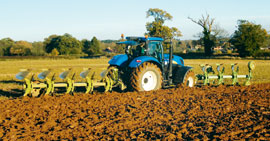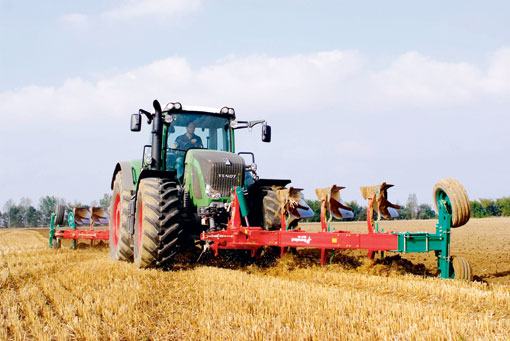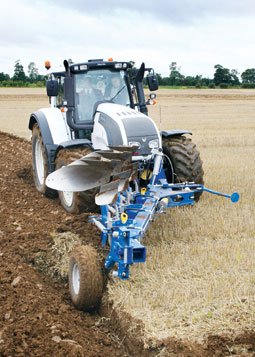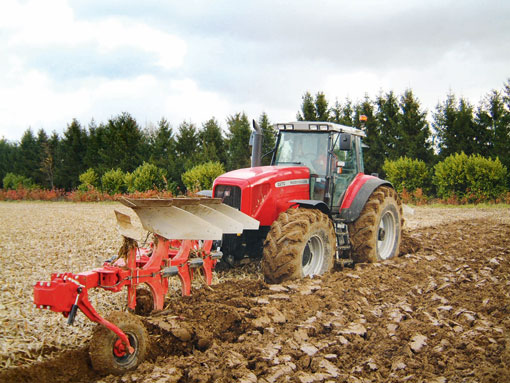Are front ploughs about to make a comeback?

Pulling out of a field or road junction with high hedges obliterating the view – that’s the first image that usually comes to mind whenever the prospect of using a front-mounted plough is mentioned.
So let’s deal with that one straight away: “That’s certainly an issue unless you’re farming on the fens where there are open road junctions,” concedes Dowdeswell Engineering design engineer, Jason Stringer.
“But it’s quite feasible to move a two- or three-furrow plough on a low-loader trailer pulled by a 4×4,” he adds. “And on a lot of farms, you’re moving from field to field without going on the road. I think with diesel the price it is, moving the front plough separately on a few occasions would be worth it for the added output you get.”
Dowdeswell Engineering plans to turn back the clock on its demonstration plot at this year’s Cereals event by showing a front-mounted plough in action for the first time since the DP8 was a regular model in its range 20 years ago.
The newcomer is derived from the 105 Series mounted reversible introduced last year for tractors up to 190hp. It will be available in two- and three-furrow sizes with shear-bolt or spring auto reset leg protection.
 Interest among farmers in France prompted Kverneland to develop a new front-mounted plough – the LD-FR with shear pin protection and the ED-FR pictured with leaf spring auto reset. |
|---|
In France, where front-mounted implements have always been more popular, a resurgence of interest in push ploughs over the past couple of years spurred Kverneland to develop a new model.
The FR is available in two- and three-furrow sizes with a choice of shear pin (LD) or leaf spring auto reset (ED) protection.
Kverneland product specialist Alan Jones says: “We get the occasional phone call about it here but very little real interest. My experience with the Ransomes front plough, which was probably one of the best, was that you need to work on level ground with a very good operator prepared to set-up and run the combination properly.”
Steve Mitchell at Kongskilde says running an Overum Xcelsior FX front plough at several public field events last year generated more than just curiosity.
 Kongskilde’s Overum Xcelsior FX plough in action; it comes with hydraulic auto reset leg protection as standard in two- and three-furrow sizes. |
|---|
“People like the idea in principle, but are uncertain about coping with the awkwardness of a front-rear combination on the road and in the field,” he says. “Certainly the man on the tractor seat has to go along with the idea because there’s obviously more to it than using a single plough.”
It does take a bit of getting used to, agrees colleague Andy Greenhill: “Just getting the sequence right, when to drop the ploughs, is difficult for some operators but others pick it up very quickly.”
Modern front-linkage designs will help the front plough’s cause, he adds, because they are stronger, more closely integrated into the front of the tractor and in some cases feature draft control.
Sweden’s national agricultural university highlighted this attraction by comparing the performance of a 135hp tractor running with a four-furrow mounted reversible on the back and either a ballast block or two-furrow plough on the front.
With the front plough increasing the working width by 50%, output on heavy clay was lifted sufficiently to trim fuel usage by 10% from 18.4-litre/ha to 16.6-litre/ha.
Mr Stringer is not surprised: “It takes diesel to move a ballast block around so it makes sense to use productive weight in the form of a front plough,” he says. “You get a more balanced outfit that will handle more furrows than with a bigger rear-mounted or semi-mounted plough.”
To illustrate the point, he highlights test work carried out with the 105 Series combination using a local farm’s 180hp tractor.
“Normally, it runs with a six-furrow mounted plough,” notes Mr Stringer. “We took off one furrow, put three on the front and it ran well with the eight furrows, looking nicely balanced with good traction all round.”
It is a relatively expensive way of adding furrows, he concedes. But a two-plough outfit offers greater flexibility than a single big implement because either one can be used on its own.
This point is echoed by Steve Mitchell at Kongskilde: “The front unit can be taken out of work when it’s not appropriate to use it – in smaller fields, for example, and working up hill. “It’s also a lot easier to work a mounted front plough into a corner.”
More Cereals 2011 kit information
 Managing a front plough used to be very tricky, but front draft systems and headland management systems are helping the situation. |
|---|

